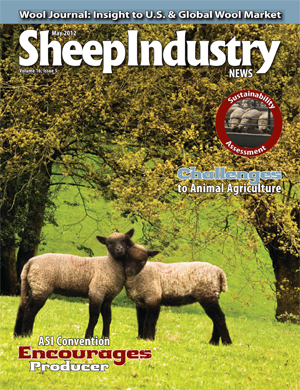Framing the Challenges to Animal Agriculture
(May 1, 2012) Animal agriculture faces significant challenges, and tremendous opportunities, in addressing growing global meat demand with limited land, high production costs and regulatory burdens. Those were some key themes at the National Institute for Animal Agriculture’s annual conference in March, which was titled “How to Advance Animal Agriculture.”
In the opening general session, economist Terry Barr, Ph.D., senior director of CoBank’s Knowledge Exchange Division, outlined some of the issues animal agriculture faces on the global stage.
Experts expect the human population to add about 3 billion people over the next 40 years, creating an enormous increase in food demand. Most of that growth will take place in Africa and Asia, Barr says. And while those regions are significantly different in levels of development they both face limitations in their potential for expanding agricultural production due to shortages of arable land, water and other resources.
Because much of the world’s arable land available for food production is located away from the centers of population growth, Barr says countries have begun arranging long-term land leases around the world to help ensure their food security.
Economic growth meanwhile, particularly in Asia, is keeping pace with population growth, as China and India move up the scale among the world’s largest economies. China, Barr says, likely will replace the United States as the world’s largest economy, in terms of gross domestic product (GDP) by 2050. About 10 percent of the people in China and India currently fall in the “middle class.” Barr expects that number to increase to about 75 percent in both countries by 2030.
Globally, between 2 billion and 3 billion more people will enter the middle class by 2030. When people become more economically secure, one of the first things they do is upgrade their diets, and Barr says a large increase in global meat consumption is likely through this transition period.
To meet the needs of 43 percent population growth by 2050, we’ll need 49-percent higher grain production and 73-percent more meat production, Barr says. Poultry will account for much of that meat production, but global beef production will need to increase by 58 percent.
Constraints on land and water use, environmental impacts and other regulatory activity rule out the possibility of simply adding enough livestock to meet future demand, Barr says. Instead, Barr says, agricultural nations need to invest heavily in research and development toward increased productivity. We’ll also need to find ways to address food-safety issues with a focus on sound science and reduce food losses or waste, which currently accounts for about 20 percent of global production.
To answer the question, can the world feed the 9 billion people excepted to inhabit the earth in 40 years? Barr thinks yes, that the food production system can achieve this goal in a sustainable matter. The question that he poses from an economist standpoint is, “What is the level of relative prices of inputs that are going to be put on the table going forward?
“I’m less concerned about our ability to feed people and more concerned about the structure of the industry as we begin to accommodate this global demand,” he concludes.
Following Barr on the program, Colorado State University President Tony Frank, DVM, Ph.D., called for a cooperative, proactive approach toward regulatory issues in animal agriculture.
Frank echoed Barr’s assertion that aggressive research and development are critical to address global hunger and its effects on security. At the same time, he acknowledges that regulatory pressures can stifle progress. One step is to understand the causes behind the regulations, in order to begin a dialog.
Consumers, he says, do not understand how food is produced, but they care about it. So they call upon their elected officials to address their concerns of accountability and safety. Elected officials create more regulations to appease consumers, the bureaucracy grows and common ground between producers and consumers shrinks.
Frank says industry needs to be proactive in breaking the cycle of confrontation and finding common ground. There are a lot of shared values between animal agriculture and consumers.
“The producers of animal agriculture want to provide a safe, high-quality product that they can produce in an ongoing, sustainable matter,” Frank says. “Nobody gets the need to sustain this over the long haul more than this industry and consumers want the same safe, high-quality product.”
Frank posed the question of how the industry breaks the cycle of mistrust and misunderstanding as food safety and sustainability issues are not going to go away, in fact, they are only going to increase.
Government can play a role in pulling groups together and universities can provide neutral, science-based solutions based on multi-disciplinary agricultural research in partnership with industry.
Recognizing the expanding global population and the need for science-based research, the American Sheep Industry Association joined 92 other organizations in supporting legislation introduced in March by Sens. Pat Roberts (Kan.) and Debbie Stabenow (Mich.) to establish the Foundation for Food and Agriculture Research (FFAR).
With an ever expanding global population and increasing demands for food and other agricultural products, increased investments in food and agricultural research are essential to maintaining our nation’s food, economic and national security. U.S. Department of Agriculture (USDA)-sponsored research is vital to achieving the agricultural production levels necessary to feed the expected worldwide population by 2050 of 9 billion people and to remain competitive in a global economy. Despite the importance of such research, current funding for food and agricultural research is less than 2.5 percent of USDA’s budget.
With the current budgetary constraints, the groups recognize the need for innovative solutions to increase funding and to leverage current and future investments in research. Establishing the FFAR will generate new sources of funding for food and agricultural research, provide a structure for new public/private partnerships to help provide funding for new concepts and ideas, research to address knowledge gaps, translational research and emerging research needs.
Reprinted in part from Drovers CattleNetwork.


